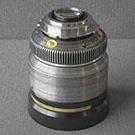
Brian Caldwell
-
Posts
153 -
Joined
-
Last visited
Reputation Activity
-
 Brian Caldwell got a reaction from richg101 in WOW ! UPDATE SPEED BOOSTER BMPCC TO -> MFT on GH4 with lens control and stabilization :P
Brian Caldwell got a reaction from richg101 in WOW ! UPDATE SPEED BOOSTER BMPCC TO -> MFT on GH4 with lens control and stabilization :P
I do appreciate your open minded spirit about using optics beyond their design intent. But just to be clear about what happens in this case - using the 0.58x Speed Booster on the GH4 in cinema 4k mode - I plotted some MTF curves below. As you can see, the performance is great over the whole BMPCC format, but if you go beyond that the performance falls off a cliff. I'm very cautious about all of this because a few users have purchased the BMPCC S.B. with the intention of using it on a larger format, only to be disappointed with the results. This is why this particular Speed Booster has always been advertised as being BMPCC-specific, and has "BMPCC" engraved on it.
-
 Brian Caldwell got a reaction from Don Kotlos in WOW ! UPDATE SPEED BOOSTER BMPCC TO -> MFT on GH4 with lens control and stabilization :P
Brian Caldwell got a reaction from Don Kotlos in WOW ! UPDATE SPEED BOOSTER BMPCC TO -> MFT on GH4 with lens control and stabilization :P
I do appreciate your open minded spirit about using optics beyond their design intent. But just to be clear about what happens in this case - using the 0.58x Speed Booster on the GH4 in cinema 4k mode - I plotted some MTF curves below. As you can see, the performance is great over the whole BMPCC format, but if you go beyond that the performance falls off a cliff. I'm very cautious about all of this because a few users have purchased the BMPCC S.B. with the intention of using it on a larger format, only to be disappointed with the results. This is why this particular Speed Booster has always been advertised as being BMPCC-specific, and has "BMPCC" engraved on it.
-
 Brian Caldwell got a reaction from jonpais in WOW ! UPDATE SPEED BOOSTER BMPCC TO -> MFT on GH4 with lens control and stabilization :P
Brian Caldwell got a reaction from jonpais in WOW ! UPDATE SPEED BOOSTER BMPCC TO -> MFT on GH4 with lens control and stabilization :P
I do appreciate your open minded spirit about using optics beyond their design intent. But just to be clear about what happens in this case - using the 0.58x Speed Booster on the GH4 in cinema 4k mode - I plotted some MTF curves below. As you can see, the performance is great over the whole BMPCC format, but if you go beyond that the performance falls off a cliff. I'm very cautious about all of this because a few users have purchased the BMPCC S.B. with the intention of using it on a larger format, only to be disappointed with the results. This is why this particular Speed Booster has always been advertised as being BMPCC-specific, and has "BMPCC" engraved on it.
-
 Brian Caldwell got a reaction from jonpais in WOW ! UPDATE SPEED BOOSTER BMPCC TO -> MFT on GH4 with lens control and stabilization :P
Brian Caldwell got a reaction from jonpais in WOW ! UPDATE SPEED BOOSTER BMPCC TO -> MFT on GH4 with lens control and stabilization :P
The 0.58x BMPCC Speed Booster is designed to cover an image circle of about 15mm diameter, which is slightly larger than the BMPCC sensor diagonal. Aberration correction is extremely good within this 15mm diameter, as is the relative illumination. However, for the GH4 4k mode you need to cover at least 17.4mm. Assuming you don't damage your camera by trying to mount the BMPCC S.B. on a GH4, you will encounter vignetting and significant image degradation in the corners. I do not recommend trying this. By contrast, the new m43 XL Speed Booster will cover the entire m43 format, not just the reduced 4k crop, and you won't have any problems with image quality. The difference between the BMPCC and XL is only 1/3 stop.
-
 Brian Caldwell got a reaction from Phil A in WOW ! UPDATE SPEED BOOSTER BMPCC TO -> MFT on GH4 with lens control and stabilization :P
Brian Caldwell got a reaction from Phil A in WOW ! UPDATE SPEED BOOSTER BMPCC TO -> MFT on GH4 with lens control and stabilization :P
The 0.58x BMPCC Speed Booster is designed to cover an image circle of about 15mm diameter, which is slightly larger than the BMPCC sensor diagonal. Aberration correction is extremely good within this 15mm diameter, as is the relative illumination. However, for the GH4 4k mode you need to cover at least 17.4mm. Assuming you don't damage your camera by trying to mount the BMPCC S.B. on a GH4, you will encounter vignetting and significant image degradation in the corners. I do not recommend trying this. By contrast, the new m43 XL Speed Booster will cover the entire m43 format, not just the reduced 4k crop, and you won't have any problems with image quality. The difference between the BMPCC and XL is only 1/3 stop.
-
 Brian Caldwell got a reaction from Jim Chang in Rectilux Extreme Low Light Test (f/1.2)
Brian Caldwell got a reaction from Jim Chang in Rectilux Extreme Low Light Test (f/1.2)
Optics is mostly simple, with some occasional complexity thrown in to make it interesting. In fact, I've almost completely forgotten all the fancy math I learned after high school, since by and large all the math you need to know to be a successful lens designer is geometry, trigonometry, and a bit of algebra.
In your case, assuming that the anamorphic portion is working at infinity (i.e., parallel light in and parallel light out) the aperture of the optical system is determined by the diameter of the iris diaphragm in the taking lens *unless* there is some other limiting aperture in the system. Imagine that you take a pin and poke a tiny hole in a large piece of aluminum foil. Next, open the f/1.2 taking lens wide open and place the aluminum foil in front of your Rectilux so that the pinhole is centered on the optical axis. Clearly, in this case the f/# of your lens system is determined by the diameter of the pinhole and not by the diameter of the taking lens' iris diaphragm. So we would say that the pinhole is the limiting aperture in your lens system.
In your case the clear aperture of the back of the anamorphic section is 43mm in diameter (assuming it is round and not rectangular). This means that the collimated on-axis beam of light exiting your anamorphic section cannot exceed 43mm in diameter, and may be less if any of the other optical surfaces in the Rectilux or your anamorphic group are limiting apertures. The entrance pupil diameter of your 85mm f/1.2 taking lens (most likely 1/3 stop faster than f/1.4, or f/1.2599 in reality) is 85/1.2599 = 67.5mm. Since 67.5mm is bigger than 43mm you are underfilling the entrance pupil of the taking lens. As a consequence, you could stop down the taking lens until its entrance pupil is reduced to 43mm, and have no impact on the actual f/# of the system. In your case, the actual maximum f/# would be f/(85/43) = f/1.98 ~ f/2, and not f/1.2. Again, this assumes that the limiting aperture of the system is the rear aperture of the anamorph, and not some other surface in the Rectilux or the anamorph. If either of the latter is true then your true f/# would be slower than f/2.
-
 Brian Caldwell got a reaction from Jim Chang in SLR Magic Rangefinder vs. FM vs. Rectilux..?
Brian Caldwell got a reaction from Jim Chang in SLR Magic Rangefinder vs. FM vs. Rectilux..?
The front element diameter doesn't have any direct affect on sharpness in the sense that you can always conjure up a counter example. For instance, I could add a foot diameter filter to the front of any taking lens and the sharpness would hardly be effected at all. Again, what really matters a lot is the entrance pupil diameter, which is the diameter of the image of aperture stop as viewed from the front of the lens.
Of course, there are limits to the sharpening effect of using a shorter focal length taking lens. If you go too short then you'll encounter aberrations and/or vignetting in the outer parts of the image.
-
 Brian Caldwell got a reaction from TheRenaissanceMan in Nikon bought Samsung NX mirrorless tech. End of Samsung NX (?)
Brian Caldwell got a reaction from TheRenaissanceMan in Nikon bought Samsung NX mirrorless tech. End of Samsung NX (?)
Everything I said is true and is backed up with hard evidence. There's no magic here - just good optics. Perhaps you might actually read the white paper I gave you a link to?
Eventually, conservative established lens makers in Japan and Germany will wake up and realize the true benefit of the Speed Booster approach for designing high-speed short BFL optics. With any luck I'll be retiring on royalties when they do
There are numerous examples of Speed Booster/lens combinations that beat native lenses. For instance, a Voigtlander 90mm/3.5 plus S.B. gives a 60mm f/2.5 that is better than the latest Olympus 60mm f/2.8 macro lens: http://***URL removed***/forums/post/51895542 . A Sigma 35/1.4 plus S.B. gives a 25/1.0 that is much better than a Voigtlander 25/0.95: http://***URL removed***/forums/post/55298481 . And these examples use the old version of the Speed Booster. The new ones referred to in my white paper are even better. Finally, I defy you to find any f/1.0 lens with better image quality than a Zeiss Otus combined with a Speed Booster Ultra.
-
 Brian Caldwell got a reaction from iamoui in Nikon bought Samsung NX mirrorless tech. End of Samsung NX (?)
Brian Caldwell got a reaction from iamoui in Nikon bought Samsung NX mirrorless tech. End of Samsung NX (?)
Everything I said is true and is backed up with hard evidence. There's no magic here - just good optics. Perhaps you might actually read the white paper I gave you a link to?
Eventually, conservative established lens makers in Japan and Germany will wake up and realize the true benefit of the Speed Booster approach for designing high-speed short BFL optics. With any luck I'll be retiring on royalties when they do
There are numerous examples of Speed Booster/lens combinations that beat native lenses. For instance, a Voigtlander 90mm/3.5 plus S.B. gives a 60mm f/2.5 that is better than the latest Olympus 60mm f/2.8 macro lens: http://***URL removed***/forums/post/51895542 . A Sigma 35/1.4 plus S.B. gives a 25/1.0 that is much better than a Voigtlander 25/0.95: http://***URL removed***/forums/post/55298481 . And these examples use the old version of the Speed Booster. The new ones referred to in my white paper are even better. Finally, I defy you to find any f/1.0 lens with better image quality than a Zeiss Otus combined with a Speed Booster Ultra.
-
 Brian Caldwell got a reaction from Emanuel in Nikon bought Samsung NX mirrorless tech. End of Samsung NX (?)
Brian Caldwell got a reaction from Emanuel in Nikon bought Samsung NX mirrorless tech. End of Samsung NX (?)
Everything I said is true and is backed up with hard evidence. There's no magic here - just good optics. Perhaps you might actually read the white paper I gave you a link to?
Eventually, conservative established lens makers in Japan and Germany will wake up and realize the true benefit of the Speed Booster approach for designing high-speed short BFL optics. With any luck I'll be retiring on royalties when they do
There are numerous examples of Speed Booster/lens combinations that beat native lenses. For instance, a Voigtlander 90mm/3.5 plus S.B. gives a 60mm f/2.5 that is better than the latest Olympus 60mm f/2.8 macro lens: http://***URL removed***/forums/post/51895542 . A Sigma 35/1.4 plus S.B. gives a 25/1.0 that is much better than a Voigtlander 25/0.95: http://***URL removed***/forums/post/55298481 . And these examples use the old version of the Speed Booster. The new ones referred to in my white paper are even better. Finally, I defy you to find any f/1.0 lens with better image quality than a Zeiss Otus combined with a Speed Booster Ultra.
-
 Brian Caldwell got a reaction from ESGI Media in Nikon bought Samsung NX mirrorless tech. End of Samsung NX (?)
Brian Caldwell got a reaction from ESGI Media in Nikon bought Samsung NX mirrorless tech. End of Samsung NX (?)
Everything I said is true and is backed up with hard evidence. There's no magic here - just good optics. Perhaps you might actually read the white paper I gave you a link to?
Eventually, conservative established lens makers in Japan and Germany will wake up and realize the true benefit of the Speed Booster approach for designing high-speed short BFL optics. With any luck I'll be retiring on royalties when they do
There are numerous examples of Speed Booster/lens combinations that beat native lenses. For instance, a Voigtlander 90mm/3.5 plus S.B. gives a 60mm f/2.5 that is better than the latest Olympus 60mm f/2.8 macro lens: http://***URL removed***/forums/post/51895542 . A Sigma 35/1.4 plus S.B. gives a 25/1.0 that is much better than a Voigtlander 25/0.95: http://***URL removed***/forums/post/55298481 . And these examples use the old version of the Speed Booster. The new ones referred to in my white paper are even better. Finally, I defy you to find any f/1.0 lens with better image quality than a Zeiss Otus combined with a Speed Booster Ultra.
-
 Brian Caldwell got a reaction from Andrew Reid in Nikon bought Samsung NX mirrorless tech. End of Samsung NX (?)
Brian Caldwell got a reaction from Andrew Reid in Nikon bought Samsung NX mirrorless tech. End of Samsung NX (?)
Everything I said is true and is backed up with hard evidence. There's no magic here - just good optics. Perhaps you might actually read the white paper I gave you a link to?
Eventually, conservative established lens makers in Japan and Germany will wake up and realize the true benefit of the Speed Booster approach for designing high-speed short BFL optics. With any luck I'll be retiring on royalties when they do
There are numerous examples of Speed Booster/lens combinations that beat native lenses. For instance, a Voigtlander 90mm/3.5 plus S.B. gives a 60mm f/2.5 that is better than the latest Olympus 60mm f/2.8 macro lens: http://***URL removed***/forums/post/51895542 . A Sigma 35/1.4 plus S.B. gives a 25/1.0 that is much better than a Voigtlander 25/0.95: http://***URL removed***/forums/post/55298481 . And these examples use the old version of the Speed Booster. The new ones referred to in my white paper are even better. Finally, I defy you to find any f/1.0 lens with better image quality than a Zeiss Otus combined with a Speed Booster Ultra.
-
 Brian Caldwell got a reaction from Andrew Reid in Nikon bought Samsung NX mirrorless tech. End of Samsung NX (?)
Brian Caldwell got a reaction from Andrew Reid in Nikon bought Samsung NX mirrorless tech. End of Samsung NX (?)
This is a false generalization most likely based on weaknesses inherent to teleconverters, which magnify aberrations. A well-designed focal reducer, on the other hand, will *shrink* the aberrations as mentioned above by Araucaria. And with a little know-how you can even do better than that to actually design a focal reducer that compensates some of the aberrations in the master lens. Here's a recent whitepaper that I wrote proving that a Metabones Speed Booster significantly increases the MTF of various lenses, including the extremely challenging case of a Zeiss Otus: http://www.metabones.com/assets/a/stories/The Perfect Focal Reducer (Metabones Speed Booster ULTRA for M43) - Whitepaper.pdf
Disclaimer: I develop the optics used in Metabones Speed Boosters
-
 Brian Caldwell got a reaction from ac6000cw in Nikon bought Samsung NX mirrorless tech. End of Samsung NX (?)
Brian Caldwell got a reaction from ac6000cw in Nikon bought Samsung NX mirrorless tech. End of Samsung NX (?)
Everything I said is true and is backed up with hard evidence. There's no magic here - just good optics. Perhaps you might actually read the white paper I gave you a link to?
Eventually, conservative established lens makers in Japan and Germany will wake up and realize the true benefit of the Speed Booster approach for designing high-speed short BFL optics. With any luck I'll be retiring on royalties when they do
There are numerous examples of Speed Booster/lens combinations that beat native lenses. For instance, a Voigtlander 90mm/3.5 plus S.B. gives a 60mm f/2.5 that is better than the latest Olympus 60mm f/2.8 macro lens: http://***URL removed***/forums/post/51895542 . A Sigma 35/1.4 plus S.B. gives a 25/1.0 that is much better than a Voigtlander 25/0.95: http://***URL removed***/forums/post/55298481 . And these examples use the old version of the Speed Booster. The new ones referred to in my white paper are even better. Finally, I defy you to find any f/1.0 lens with better image quality than a Zeiss Otus combined with a Speed Booster Ultra.
-
 Brian Caldwell got a reaction from Nikkor in Nikon bought Samsung NX mirrorless tech. End of Samsung NX (?)
Brian Caldwell got a reaction from Nikkor in Nikon bought Samsung NX mirrorless tech. End of Samsung NX (?)
Everything I said is true and is backed up with hard evidence. There's no magic here - just good optics. Perhaps you might actually read the white paper I gave you a link to?
Eventually, conservative established lens makers in Japan and Germany will wake up and realize the true benefit of the Speed Booster approach for designing high-speed short BFL optics. With any luck I'll be retiring on royalties when they do
There are numerous examples of Speed Booster/lens combinations that beat native lenses. For instance, a Voigtlander 90mm/3.5 plus S.B. gives a 60mm f/2.5 that is better than the latest Olympus 60mm f/2.8 macro lens: http://***URL removed***/forums/post/51895542 . A Sigma 35/1.4 plus S.B. gives a 25/1.0 that is much better than a Voigtlander 25/0.95: http://***URL removed***/forums/post/55298481 . And these examples use the old version of the Speed Booster. The new ones referred to in my white paper are even better. Finally, I defy you to find any f/1.0 lens with better image quality than a Zeiss Otus combined with a Speed Booster Ultra.
-
 Brian Caldwell got a reaction from Timotheus in Rectilux Extreme Low Light Test (f/1.2)
Brian Caldwell got a reaction from Timotheus in Rectilux Extreme Low Light Test (f/1.2)
Optics is mostly simple, with some occasional complexity thrown in to make it interesting. In fact, I've almost completely forgotten all the fancy math I learned after high school, since by and large all the math you need to know to be a successful lens designer is geometry, trigonometry, and a bit of algebra.
In your case, assuming that the anamorphic portion is working at infinity (i.e., parallel light in and parallel light out) the aperture of the optical system is determined by the diameter of the iris diaphragm in the taking lens *unless* there is some other limiting aperture in the system. Imagine that you take a pin and poke a tiny hole in a large piece of aluminum foil. Next, open the f/1.2 taking lens wide open and place the aluminum foil in front of your Rectilux so that the pinhole is centered on the optical axis. Clearly, in this case the f/# of your lens system is determined by the diameter of the pinhole and not by the diameter of the taking lens' iris diaphragm. So we would say that the pinhole is the limiting aperture in your lens system.
In your case the clear aperture of the back of the anamorphic section is 43mm in diameter (assuming it is round and not rectangular). This means that the collimated on-axis beam of light exiting your anamorphic section cannot exceed 43mm in diameter, and may be less if any of the other optical surfaces in the Rectilux or your anamorphic group are limiting apertures. The entrance pupil diameter of your 85mm f/1.2 taking lens (most likely 1/3 stop faster than f/1.4, or f/1.2599 in reality) is 85/1.2599 = 67.5mm. Since 67.5mm is bigger than 43mm you are underfilling the entrance pupil of the taking lens. As a consequence, you could stop down the taking lens until its entrance pupil is reduced to 43mm, and have no impact on the actual f/# of the system. In your case, the actual maximum f/# would be f/(85/43) = f/1.98 ~ f/2, and not f/1.2. Again, this assumes that the limiting aperture of the system is the rear aperture of the anamorph, and not some other surface in the Rectilux or the anamorph. If either of the latter is true then your true f/# would be slower than f/2.
-
 Brian Caldwell got a reaction from Nikkor in Nikon bought Samsung NX mirrorless tech. End of Samsung NX (?)
Brian Caldwell got a reaction from Nikkor in Nikon bought Samsung NX mirrorless tech. End of Samsung NX (?)
I would expect to see some degradation due to the filter stack. However, the 28/1.4 Nikkor is reasonably telecentric AFAIK, so it should have less of the filter-induced astigmatism that plagues other designs. Probably most of what you are seeing is due to the d800 having vastly cleaner and more detailed images than 35mm film, so its just showing faults in the lens that were always there.
-
 Brian Caldwell got a reaction from TheRenaissanceMan in Nikon bought Samsung NX mirrorless tech. End of Samsung NX (?)
Brian Caldwell got a reaction from TheRenaissanceMan in Nikon bought Samsung NX mirrorless tech. End of Samsung NX (?)
This is a false generalization most likely based on weaknesses inherent to teleconverters, which magnify aberrations. A well-designed focal reducer, on the other hand, will *shrink* the aberrations as mentioned above by Araucaria. And with a little know-how you can even do better than that to actually design a focal reducer that compensates some of the aberrations in the master lens. Here's a recent whitepaper that I wrote proving that a Metabones Speed Booster significantly increases the MTF of various lenses, including the extremely challenging case of a Zeiss Otus: http://www.metabones.com/assets/a/stories/The Perfect Focal Reducer (Metabones Speed Booster ULTRA for M43) - Whitepaper.pdf
Disclaimer: I develop the optics used in Metabones Speed Boosters
-
 Brian Caldwell got a reaction from Nikkor in Nikon bought Samsung NX mirrorless tech. End of Samsung NX (?)
Brian Caldwell got a reaction from Nikkor in Nikon bought Samsung NX mirrorless tech. End of Samsung NX (?)
This is a false generalization most likely based on weaknesses inherent to teleconverters, which magnify aberrations. A well-designed focal reducer, on the other hand, will *shrink* the aberrations as mentioned above by Araucaria. And with a little know-how you can even do better than that to actually design a focal reducer that compensates some of the aberrations in the master lens. Here's a recent whitepaper that I wrote proving that a Metabones Speed Booster significantly increases the MTF of various lenses, including the extremely challenging case of a Zeiss Otus: http://www.metabones.com/assets/a/stories/The Perfect Focal Reducer (Metabones Speed Booster ULTRA for M43) - Whitepaper.pdf
Disclaimer: I develop the optics used in Metabones Speed Boosters
-
 Brian Caldwell got a reaction from teddoman in Nikon bought Samsung NX mirrorless tech. End of Samsung NX (?)
Brian Caldwell got a reaction from teddoman in Nikon bought Samsung NX mirrorless tech. End of Samsung NX (?)
This is a false generalization most likely based on weaknesses inherent to teleconverters, which magnify aberrations. A well-designed focal reducer, on the other hand, will *shrink* the aberrations as mentioned above by Araucaria. And with a little know-how you can even do better than that to actually design a focal reducer that compensates some of the aberrations in the master lens. Here's a recent whitepaper that I wrote proving that a Metabones Speed Booster significantly increases the MTF of various lenses, including the extremely challenging case of a Zeiss Otus: http://www.metabones.com/assets/a/stories/The Perfect Focal Reducer (Metabones Speed Booster ULTRA for M43) - Whitepaper.pdf
Disclaimer: I develop the optics used in Metabones Speed Boosters
-
 Brian Caldwell got a reaction from valid in Rectilux Extreme Low Light Test (f/1.2)
Brian Caldwell got a reaction from valid in Rectilux Extreme Low Light Test (f/1.2)
Optics is mostly simple, with some occasional complexity thrown in to make it interesting. In fact, I've almost completely forgotten all the fancy math I learned after high school, since by and large all the math you need to know to be a successful lens designer is geometry, trigonometry, and a bit of algebra.
In your case, assuming that the anamorphic portion is working at infinity (i.e., parallel light in and parallel light out) the aperture of the optical system is determined by the diameter of the iris diaphragm in the taking lens *unless* there is some other limiting aperture in the system. Imagine that you take a pin and poke a tiny hole in a large piece of aluminum foil. Next, open the f/1.2 taking lens wide open and place the aluminum foil in front of your Rectilux so that the pinhole is centered on the optical axis. Clearly, in this case the f/# of your lens system is determined by the diameter of the pinhole and not by the diameter of the taking lens' iris diaphragm. So we would say that the pinhole is the limiting aperture in your lens system.
In your case the clear aperture of the back of the anamorphic section is 43mm in diameter (assuming it is round and not rectangular). This means that the collimated on-axis beam of light exiting your anamorphic section cannot exceed 43mm in diameter, and may be less if any of the other optical surfaces in the Rectilux or your anamorphic group are limiting apertures. The entrance pupil diameter of your 85mm f/1.2 taking lens (most likely 1/3 stop faster than f/1.4, or f/1.2599 in reality) is 85/1.2599 = 67.5mm. Since 67.5mm is bigger than 43mm you are underfilling the entrance pupil of the taking lens. As a consequence, you could stop down the taking lens until its entrance pupil is reduced to 43mm, and have no impact on the actual f/# of the system. In your case, the actual maximum f/# would be f/(85/43) = f/1.98 ~ f/2, and not f/1.2. Again, this assumes that the limiting aperture of the system is the rear aperture of the anamorph, and not some other surface in the Rectilux or the anamorph. If either of the latter is true then your true f/# would be slower than f/2.
-
 Brian Caldwell got a reaction from Bioskop.Inc in Rectilux Extreme Low Light Test (f/1.2)
Brian Caldwell got a reaction from Bioskop.Inc in Rectilux Extreme Low Light Test (f/1.2)
Optics is mostly simple, with some occasional complexity thrown in to make it interesting. In fact, I've almost completely forgotten all the fancy math I learned after high school, since by and large all the math you need to know to be a successful lens designer is geometry, trigonometry, and a bit of algebra.
In your case, assuming that the anamorphic portion is working at infinity (i.e., parallel light in and parallel light out) the aperture of the optical system is determined by the diameter of the iris diaphragm in the taking lens *unless* there is some other limiting aperture in the system. Imagine that you take a pin and poke a tiny hole in a large piece of aluminum foil. Next, open the f/1.2 taking lens wide open and place the aluminum foil in front of your Rectilux so that the pinhole is centered on the optical axis. Clearly, in this case the f/# of your lens system is determined by the diameter of the pinhole and not by the diameter of the taking lens' iris diaphragm. So we would say that the pinhole is the limiting aperture in your lens system.
In your case the clear aperture of the back of the anamorphic section is 43mm in diameter (assuming it is round and not rectangular). This means that the collimated on-axis beam of light exiting your anamorphic section cannot exceed 43mm in diameter, and may be less if any of the other optical surfaces in the Rectilux or your anamorphic group are limiting apertures. The entrance pupil diameter of your 85mm f/1.2 taking lens (most likely 1/3 stop faster than f/1.4, or f/1.2599 in reality) is 85/1.2599 = 67.5mm. Since 67.5mm is bigger than 43mm you are underfilling the entrance pupil of the taking lens. As a consequence, you could stop down the taking lens until its entrance pupil is reduced to 43mm, and have no impact on the actual f/# of the system. In your case, the actual maximum f/# would be f/(85/43) = f/1.98 ~ f/2, and not f/1.2. Again, this assumes that the limiting aperture of the system is the rear aperture of the anamorph, and not some other surface in the Rectilux or the anamorph. If either of the latter is true then your true f/# would be slower than f/2.
-
 Brian Caldwell got a reaction from Tito Ferradans in Rectilux Extreme Low Light Test (f/1.2)
Brian Caldwell got a reaction from Tito Ferradans in Rectilux Extreme Low Light Test (f/1.2)
Optics is mostly simple, with some occasional complexity thrown in to make it interesting. In fact, I've almost completely forgotten all the fancy math I learned after high school, since by and large all the math you need to know to be a successful lens designer is geometry, trigonometry, and a bit of algebra.
In your case, assuming that the anamorphic portion is working at infinity (i.e., parallel light in and parallel light out) the aperture of the optical system is determined by the diameter of the iris diaphragm in the taking lens *unless* there is some other limiting aperture in the system. Imagine that you take a pin and poke a tiny hole in a large piece of aluminum foil. Next, open the f/1.2 taking lens wide open and place the aluminum foil in front of your Rectilux so that the pinhole is centered on the optical axis. Clearly, in this case the f/# of your lens system is determined by the diameter of the pinhole and not by the diameter of the taking lens' iris diaphragm. So we would say that the pinhole is the limiting aperture in your lens system.
In your case the clear aperture of the back of the anamorphic section is 43mm in diameter (assuming it is round and not rectangular). This means that the collimated on-axis beam of light exiting your anamorphic section cannot exceed 43mm in diameter, and may be less if any of the other optical surfaces in the Rectilux or your anamorphic group are limiting apertures. The entrance pupil diameter of your 85mm f/1.2 taking lens (most likely 1/3 stop faster than f/1.4, or f/1.2599 in reality) is 85/1.2599 = 67.5mm. Since 67.5mm is bigger than 43mm you are underfilling the entrance pupil of the taking lens. As a consequence, you could stop down the taking lens until its entrance pupil is reduced to 43mm, and have no impact on the actual f/# of the system. In your case, the actual maximum f/# would be f/(85/43) = f/1.98 ~ f/2, and not f/1.2. Again, this assumes that the limiting aperture of the system is the rear aperture of the anamorph, and not some other surface in the Rectilux or the anamorph. If either of the latter is true then your true f/# would be slower than f/2.
-
 Brian Caldwell got a reaction from Bioskop.Inc in Rectilux Extreme Low Light Test (f/1.2)
Brian Caldwell got a reaction from Bioskop.Inc in Rectilux Extreme Low Light Test (f/1.2)
Is it possible that you are underfilling the entrance pupil of the 85/1.2, and hence not actually shooting at f/1.2? For example, if you were shooting with an iscorama-36 the limiting aperture would be the 36mm diameter at the rear of the anamorphic section, thus giving you a maximum aperture of f/(85/36) ~ f/2.4
-
 Brian Caldwell got a reaction from Nikkor in Rectilux Extreme Low Light Test (f/1.2)
Brian Caldwell got a reaction from Nikkor in Rectilux Extreme Low Light Test (f/1.2)
Is it possible that you are underfilling the entrance pupil of the 85/1.2, and hence not actually shooting at f/1.2? For example, if you were shooting with an iscorama-36 the limiting aperture would be the 36mm diameter at the rear of the anamorphic section, thus giving you a maximum aperture of f/(85/36) ~ f/2.4












